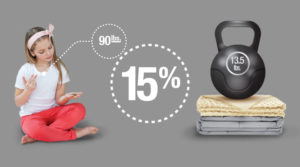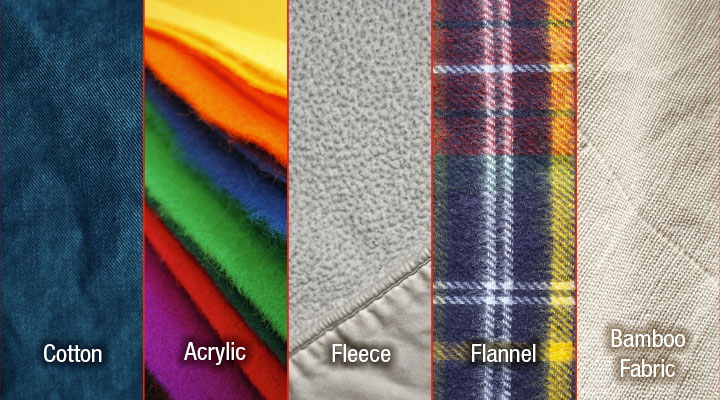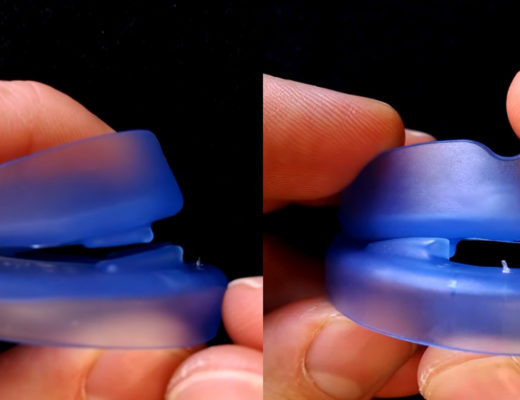Weighted blankets are a wonderful tool for helping children and adults alike get a deeper, more meaningful sleep. The additional weight helps the user feel more secure, reduces excess movement, and prompts the body to release more serotonin and melatonin. Ultimately, weighted blankets help your mind and body ease into a state of relaxation. But many people who pass over these incredible sleep aids believe that the added weight will actually make them hotter, defeating their designed purpose.
 So the question many have is this: do weighted blankets make your hotter when you sleep? The answer is yes, they can, but it depends on what they are made of. Like with clothing, blankets are made with different material, some heavier than others. While much of the heftiness of a weighted blanket doesn’t come from its fabric (it instead comes from the materials used in its filling), heavier material will directly impact heat retention.
So the question many have is this: do weighted blankets make your hotter when you sleep? The answer is yes, they can, but it depends on what they are made of. Like with clothing, blankets are made with different material, some heavier than others. While much of the heftiness of a weighted blanket doesn’t come from its fabric (it instead comes from the materials used in its filling), heavier material will directly impact heat retention.
If you want to experience the joys of a weighted blanket without the risk of a sweaty, sleepless night, consider the following tips. Doing so could make the difference between catching more Zs and tossing and turning all night.
Check Out the Filler Material
The weight of the blanket comes from the material used at its filler. Though there are many varieties of fillers used today, they can be simplified and divided into two groups: organic and inorganic. Natural fillers, such as sand, fall into the first category. Man-made materials, like plastic pellets, fall into the second. Since the filler is what retains the vast majority of the heat in a blanket, knowing the difference is crucial to getting the best sleep possible.
Studies and customer reports show time and time again that weighted blankets with organic fillers retain far more heat. Though they’re popular for being natural and, if need be, easily adjustable, they become problematic during summer months or in wet, warm climates in general. Inorganic pellets and beads, on the other hand, trap and retain much less heat. However, short of having some extra pellets on hand (and let’s face it—who keeps plastic pellets just in case?), you’ll find it difficult to add more weight to such blankets.
Personal preference for the physical feeling of the filling is among the biggest deciding factors for first-time buyers. A filling like sand is looked upon more favorably because the weight distribution is more even across the body. The physical sensation is more appealing, but judging by this alone overlooks potential discomfort resulting from increased temperature. Before you settle on a blanket, research the material used as a filling and see what other customers say about it.
Size Doesn’t Matter, But Weight Does
 There are no universal measurements for weighted blankets. Manufacturers have their own definitions of what constitutes small, medium, large, etc., but for the most part, the length and width of the blanket don’t matter much. As long as it covers most of your body, it will do its job. A few inches too many (or too few) won’t change that. Just remember that a weighted blanket is designed to fit you and not necessarily your entire bed.
There are no universal measurements for weighted blankets. Manufacturers have their own definitions of what constitutes small, medium, large, etc., but for the most part, the length and width of the blanket don’t matter much. As long as it covers most of your body, it will do its job. A few inches too many (or too few) won’t change that. Just remember that a weighted blanket is designed to fit you and not necessarily your entire bed.
Weight, on the other hand, is a different issue. Depending on the material used as filler, a heavier blanket could raise your body temperature significantly. The general consensus is that your weighted blanket should only weigh 15% of what your yourself weight, give or take a few pounds. Of course, we’re all different shapes and sizes, so if you want to be precise you may need to resort to having one custom made.
Think About Fabric

As mentioned above, a blanket’s weight comes down to the filling. But that doesn’t mean the exterior fabric can be overlooked when it comes to keeping things cool. Think of how clothes made with different fabrics make you feel. The same principles apply with blankets.
Cotton
Cotton is, by and far, the best choice for weighted blankets. Also cotton is breathable, hypoallergenic, easy to wash, and incredibly lightweight. However, be aware that organic cotton blankets can carry a higher price tag but are devoid of potentially harmful chemicals. Those with particular heat or textural sensitivities may want to consider a satin-cotton blend; it’s somewhat cooler during colder months and has a much smoother surface thanks to the satin.
Acrylic
Those seeking a close alternative to natural fabrics like cotton may find comfort in acrylic. Although it’s a synthetic fiber, it feels and acts as a natural fiber but at a much lower cost. Acrylic does an excellent job of wicking sweat and moisture from your body, making nighttime sweats a thing of the past. But perhaps the biggest boon of acrylic is how easy it is to wash and care for.
The filling of an acrylic blanket is especially important because the fabric itself will hold onto heat for long periods of time. While it handles any resulting sweat without issue, it can still create an uncomfortably warm sleeping situation. Pairing it with inorganic filling can help offset this.
Fleece
People love fleece because of how very cozy it is without triggering textural sensitives, like the itchiness that can come with wool. It comes in several different varieties but all are synthetic and fairly inexpensive.
But like the other fabrics detailed here, this one has its weaknesses. Fleece is incredibly difficult to keep clean; it retains odors from sweat (as well as giving off its own chemical smell), stains easily, and collects small organic materials like hair and dust. Germaphobes will be put on edge trying to keep fleece in pristine condition.
Flannel
If you’re a fan of flannel pajamas, then you already know what to expect from a flannel weighted blanket. Easy to maintain, they offer similar breathability to cotton but with higher heat retention. While a flannel blanket will never be your go-to during summer, it can be your best friend during those icy winter months. Blankets manufactured with flannel come in different levels of thickness, so if you like to keep things toasty that’s an option.
The downside of flannel, though, is that’s it’s incredibly flammable. This is a non-issue if you keep your bed a safe distance away from any heaters or electronic devices. Otherwise, you’ll need to reconsider your bedroom composition and habits to keep yourself safe.
Bamboo fabric
Browsing around, you may have seen bamboo fabric weighted blankets. The name raises an eyebrow until you learn that the fabric blend includes polyester, cotton, and bamboo rayon, all of which come together to create an amazingly soft and smooth blanket. It also keeps cool throughout the night, regardless of how warm you may be.
That being said, bamboo fabric has a relatively short shelf life. It also loses its softness faster than other fabrics. Even if that doesn’t bother you, bamboo fabric can be an easy place for mold to grow quickly. Though a blanket made of this material is machine-wash-friendly, you’ll need to be more alert with your maintenance to keep things healthy.
Cotton tends to be the most commonly used fabric for weighted blankets, and if you search around you’ll find plenty of arguments supporting it as the best option. But we’re all different, of course, and your personal preferences and the climate you live in will ultimately determine what will bring you the most comfort. Finding your perfect fit starts with the fabric, but there are still other steps you can take to help keep the heat down when you’re snug under the covers.
Removable Padding/Covers
Some companies manufacture weighted blankets with removable layers to help accommodate for those sweaty nights. They can usually be added or removed with simple zippers. How much of a difference they make will depend on what they are made of and how much is actually removed with each layer.
Rethink Your Sheets
It’s not just about what’s on top of you! Your bed sheets can just as easily absorb and retain your body heat, contributing to your late-night sweats. Research the material its made off to see if any of the sheet’s properties could be raising the temperature on you. Here’s a good rule of thumb to work by: if you’re comfortable with your weighted blanket, get sheets to match the fabric.
Remove the Electronics
How many of us strictly use our bedrooms as places to sleep? If you’re like most people, you probably have a television against the bedroom wall, or you have a small office set up in the corner with a computer and monitor. There could be a digital clock on the nightstand or smartphones charging within an arm’s reach of the bed itself.
As convenient as all of these things can be, they could be culprits in turning up the heat. When they’re plugged in they can generate heat, even if they aren’t turned on. This also includes battery-operated devices. The less of these you have near the bed, the better, but for the best results you should remove them from your bedroom entirely. Keep only what is absolutely essential.
Get Hydrated Before Bedtime
One of the ways your body regulates its temperature is through hydration. It’s been drilled into our heads to drink water throughout the day to stay healthy. But drinking any before hitting the hay will have us getting out of bed and urinating throughout the night. That second piece may sound logical, but not only is it untrue. It could also be responsible for a lot of nighttime discomforts.
While you don’t want to chug down a few bottles before slinking off to sleep. One small glass of water will keep your body hydrated for the six to eight hours you’re asleep. The small amount won’t be enough to wake you up for a bathroom break. But it will continue to keep your body cool long after you’ve nodded off.
Try Weighted Sheets
Weighted sheets work to hold you still and in position, just like a weighted blanket but do so by utilizing tension. They’re significantly lighter since they have no filling material and hold much less heat. A weighted sheet will stretch over your bed and wrap snugly around you, too.
If you live in a part of the world that’s hot year-round, weighted sheets are your best alternative to weighted blankets. They’re also a great substitute for summertime nights when the blanket is just too much. And unlike their blanket counterparts, whose bulkiness can make storage tricky, weighted sheets are easily folded and tucked away. You can even keep them on the bed when you aren’t using them as covers.
Check Out Specialty Blankets
If you’re really set on finding a weighted blanket perfect for nights hot and cold, you could try out a specialty blanket. Some manufacturers advertise blankets that will keep you comfortable year-round without leaving you too warm or too cold. Though they go by different names (with “all seasons” being a popular description used), most make use of different combinations of materials outlined above to achieve their goal.
Some can be quite experimental, however, and it may be difficult to judge how effective they are without trying them for yourself. On top of that, the extra effort that goes into making specialty weighted blankets means a higher than average price tag. If your attempts to cool off with a weighted blanket are leaving you frustrated, don’t head straight for a specialty blanket without trying other methods first. Your wallet will thank you.
Be Ready To Make Some Changes
While there’s always a chance that you may experience overheating when sleeping beneath a weighted blanket, researching your options before making the purchase will give you a better idea of what you can expect when bedtime comes and the temperature outside rises. There’s no perfect blanket for those hot nights, but by adjusting certain aspects of your nighttime routine and your sleep environment, you can better acclimate yourself to whatever heat your blanket will retain and save yourself the time, money, and hassle of replacing it.







